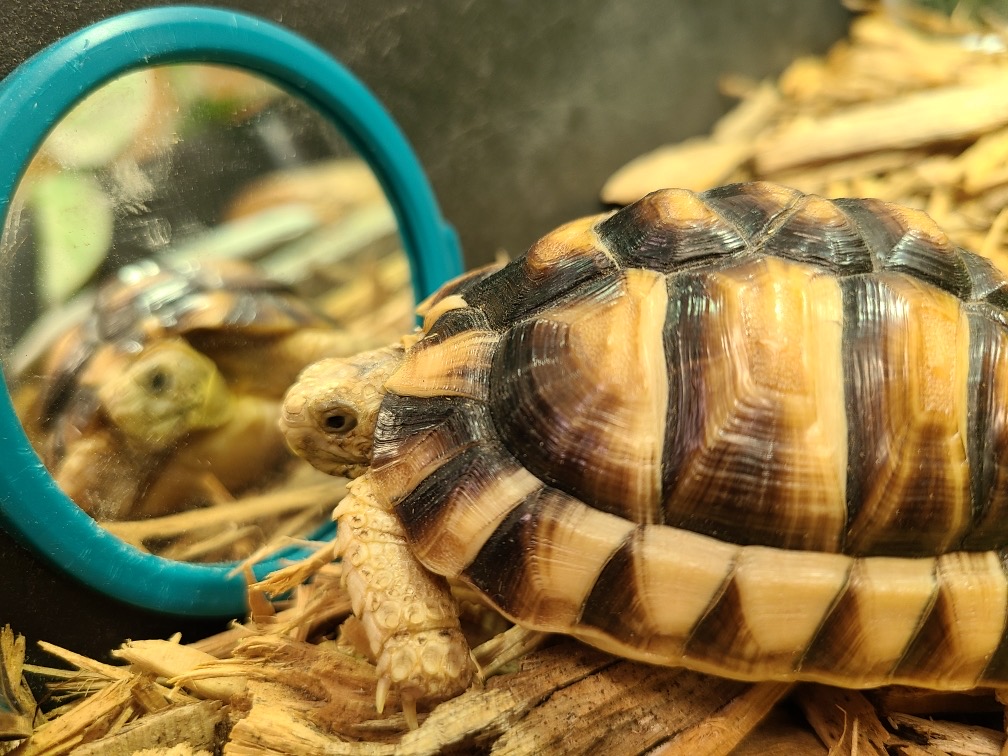
Scientific name
Testudo kleinmanni
Common name
Eyptian tortoise, Kleinmann's tortoise, Leith's tortoise, and the Negev tortoise
Conservation status
Critically Endangered
Taxonomy
- Kingdom: Animalia
- Phylum: Chordata
- Class: Reptilia
- Order: Testudines
- Family: Testudinidae
- Genus: Testudo
- Species: Testudo kleinmanni
Habitat
Harsh desert and semi-desert climates
Geographic range
Libya, Egypt, and Israel coastal strip
Our Animals Names
Horus and Nut (pronounced “newt”)
Favorite enrichment item
Hides, ball pits, and mirrors
Life span
In the wild: 50+ years
In human care: 70 to 100+ years
Diet
In the wild: Leaves and flowers of desert plants like succulents.
At the Zoo: Leafy greens, vegetables, and a small amount of fruit.
Location in Zoo
Horus and Nut are members of our Ambassador Animals that live behind the scenes! If you would like to meet them in person, check out our daily, 11AM Amphitheater Presentations at the Awareness Amphitheater, located just beyond the covered bridge. Amphitheater Presentations are dependent on the weather. Please check our activity board, behind the Admissions booth, before coming to see us!
Meet Horus and Nut: Tiny Tortoises with a Big Story
Say hello to Horus and Nut, two of the tiniest tortoises in the world—and two of the rarest. Egyptian tortoises, reach just 4 to 6 inches in length when fully grown—that’s about the size of a standard stapler! But don’t be fooled by their small size. These little reptiles are desert survivalists, built for life in some of the harshest conditions on the planet.
Desert Champions
Native to the arid landscapes of Libya, Egypt, and Israel, Egyptian tortoises have evolved an incredible array of adaptations to survive in extreme environments.
Their pale-yellow shells serve a dual purpose: camouflage and heat reflection. This coloration helps them blend into sandy surroundings while also deflecting sunlight, keeping their bodies cooler under the desert sun.
Water is scarce in their native habitat, but these tortoises rarely need to drink. They rely on metabolic water—moisture obtained from the succulent plants, leaves, and flowers they consume.
To avoid the midday heat, they take shelter under shrubs or in abandoned rodent burrows. Like all reptiles, Egyptian tortoises are ectothermic, meaning they regulate their body temperature using the environment rather than internal mechanisms. While they’re considered diurnal (active during the day), Horus and Nut are smart about their routines, becoming most active at dawn and dusk when temperatures are more tolerable.
Even their tiny size is an advantage—it helps them warm up and cool down more quickly, allowing them to adapt rapidly to dramatic temperature swings between day and night.
What’s on the Menu?
Egyptian tortoises are herbivores, surviving on a diet of hardy desert plants. In the wild, they snack on nutrient-rich succulents that also help hydrate their bodies. At the zoo, Horus and Nut enjoy a specially designed diet that includes leafy greens, vegetables, and the occasional fruit to support their health and mimic their natural food sources.
Conservation: A Race Against Time
Once widespread across parts of North Africa and the Middle East, Egyptian tortoises have now vanished from much of their historical range. Today, Libya is their last stronghold in the wild.
They are currently listed as Critically Endangered, with major threats including:
- Habitat loss due to human development, agriculture, and conflict
- Climate change, which alters delicate desert ecosystems
- The illegal pet trade, which removes individuals from wild populations
Conservation programs—such as those run by AZA-accredited zoos and aquariums—are working hard to protect these tortoises through breeding, habitat preservation, and education. Horus and Nut are part of that mission, serving as ambassadors to inspire change and spread awareness.
Not a Pet
Despite their size and charm, Egyptian tortoises are not suitable pets. They require highly specialized care and taking them from the wild is often illegal—and always harmful to conservation efforts.
How you can help:
- Never buy wild-caught tortoises
- Say NO to the exotic pet trade
- Support organizations like the Turtle Survival Alliance
- Visit AZA-accredited zoos and aquariums that focus on responsible animal care
- Educate others about why wild animals don’t belong in private homes
Sadly, many tortoises end up in rescues or living in poor conditions when people realize how difficult they are to care for. If you want to learn more about why domestic animals make better companions, check out the Not-a-Pet campaign.
Why Horus and Nut Matter
Even if they’re not always out and about for everyone to see, Horus and Nut play a vital role in conservation education. By learning about them—and the fragile desert ecosystems they call home—we take a meaningful step toward protecting their species and ensuring these remarkable reptiles continue to roam the sands for generations to come.
Fun Facts About Egyptian Tortoises
- Tiny but mighty: One of the smallest tortoise species in the world, maxing out at just 6 inches long.
- Built-in sunscreen: Their pale shells reflect sunlight to keep them cool in the desert.
- Hydration hacks: They rely on metabolic water from food rather than drinking.
- Masters of timing: Active mostly at dawn and dusk to avoid extreme temperatures.
- Ecosystem engineers: By grazing on plants, they help shape and maintain desert habitats.
- Vanishing act: Once widespread, they’re now mostly limited to Libya and are critically endangered.
- Not-a-Pet: Specialized needs and legal protections mean they’re best left in the wild or under expert care.
